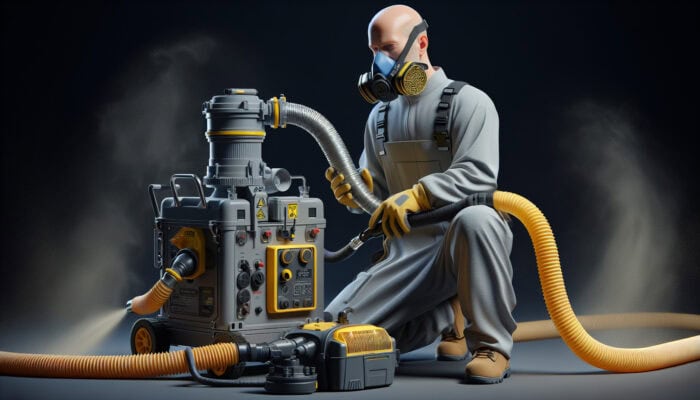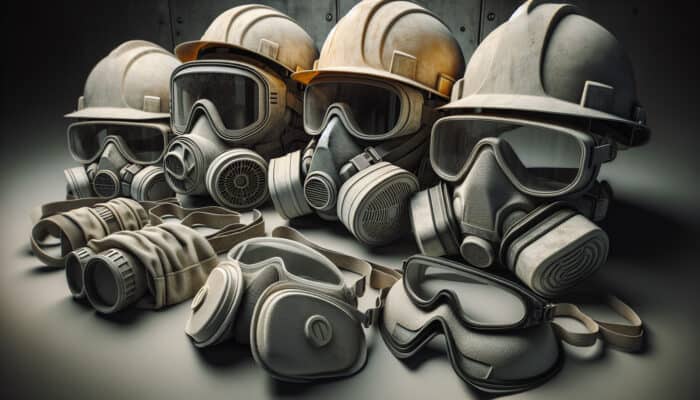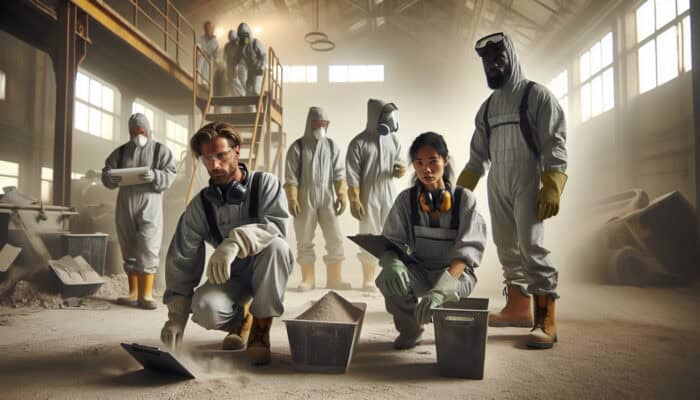Implement Effective Dust Protection Strategies for Successful Clearance Operations
Discover Key Tools Essential for Dust Protection During Clearance Work

dust protection tools are indispensable for ensuring both safety and operational efficiency during clearance work. These specialised tools are designed to significantly minimise exposure to harmful dust particles, protecting the health of workers while also maintaining a cleaner and safer working environment. The most commonly used dust protection tools encompass:
- Respirators and masks specifically designed to filter airborne particles
- Dust extraction systems that capture dust at its source
- Protective clothing such as coveralls that provide a barrier against dust
- Gloves to protect hands from irritants, and goggles to shield eyes from particles
- HEPA filters that trap even the smallest dust particles
- Dust suppression sprays that dampen dust generation
- Vacuum systems designed for dust collection
- Face shields for additional face protection
These protective tools play a crucial role in preventing airborne dust, thereby significantly reducing health risks for workers engaged in various clearance activities, whether in residential, commercial, or industrial settings.
Understanding the Importance of Dust Control in Clearance Operations
Effective dust control is of utmost importance in clearance jobs due to the multitude of health risks associated with dust exposure. Inhaling dust can lead to serious respiratory issues, long-term health complications, and can exacerbate pre-existing conditions such as asthma or chronic obstructive pulmonary disease (COPD). Moreover, the build-up of dust can impair visibility and create unsafe working conditions.
The health risks linked to dust exposure include:
- Respiratory diseases that can severely impact overall health
- Allergic reactions resulting from inhaling particulate matter
- Lung cancer, a severe outcome of prolonged exposure to toxic dust
- Silicosis and asbestosis, conditions caused by inhaling silica and asbestos respectively
- Skin irritation from direct contact with dust
- Cardiovascular issues linked to respiratory strain
- Chronic bronchitis resulting from continuous dust exposure
- Increased risk of infections due to compromised respiratory health
Implementing effective dust control measures not only protects the health of workers but also enhances air quality, resulting in a more productive and safe working environment.
Examining the Regulatory Standards for Dust Management in the UK
In the UK, the regulations surrounding dust management in clearance jobs are stringent and aimed at protecting both workers and the environment. The Control of Substances Hazardous to Health Regulations (COSHH) clearly outlines the responsibilities of employers to ensure that dust levels are kept within acceptable limits. Employers are obligated to conduct thorough risk assessments, implement effective control measures, and provide comprehensive training for their staff.
Furthermore, the Health and Safety Executive (HSE) issues guidelines detailing the necessary actions for managing dust-related risks effectively. Compliance with these regulations is not only a legal requirement but also essential for fostering a safe working environment. Failure to adhere to these standards can result in severe penalties and legal repercussions.
In-Depth Analysis of Dust Protection Equipment for Clearance Jobs

Comprehending the Functionality of Respiratory Protection Devices
Respiratory protection devices, which include masks and respirators, are vital for safeguarding workers from inhaling harmful dust particles during clearance tasks. These devices are engineered to effectively filter out dangerous particulate matter and provide a clean air supply to the user. There are various types of respiratory devices available, including disposable masks, reusable respirators, and powered air-purifying respirators (PAPRs).
The choice of respiratory protection is contingent upon several factors, such as the intensity of dust exposure, the nature of the dust being handled, and the duration of exposure. Disposable masks are commonly used in situations involving low dust exposure, while more advanced respirators are necessary for tasks involving high concentrations of toxic dust, such as asbestos or silica.
Training on the proper use and upkeep of respiratory protection devices is crucial, as incorrect usage can greatly diminish their effectiveness. Regular fit testing is also essential to ensure that the equipment provides the necessary level of protection.
Understanding the Mechanism of Dust Extraction Systems
Dust extraction systems are specifically designed to eliminate dust at its source, preventing its spread and accumulation within the work area. These systems can be integrated into machinery or operate as standalone units, capturing dust particles directly from activities such as cutting, grinding, or demolition.
An effective dust extraction system significantly improves air quality, contributing to a safer working environment. High-efficiency particulate air (HEPA) filters are often employed within these systems, as they can capture particles as small as 0.3 microns, ensuring that the majority of harmful dust is filtered out.
Regular maintenance and servicing of dust extraction systems are essential for optimal performance. Clogged filters or malfunctioning components can impair effectiveness, leading to increased dust levels and heightened health risks for workers.
Selecting Appropriate Protective Clothing and Gear for Safety

Protective clothing and gear, including coveralls, gloves, and goggles, are essential for shielding workers from dust exposure and the associated hazards during clearance jobs. These garments are specifically designed to resist dust infiltration and prevent skin contact with harmful materials.
When selecting protective clothing, factors to consider include the type of dust, the duration of exposure, and the specific tasks being performed. Lightweight, breathable coveralls may suffice for less hazardous work, while more robust, sealed suits are necessary for tasks involving toxic substances.
In addition to clothing, workers should be provided with supplementary protective gear, such as gloves to protect their hands from irritation and goggles to shield their eyes from dust particles. Regular inspections of equipment are necessary to ensure they remain in excellent condition and continue to provide the required level of protection.
Strategically Selecting the Right Dust Protection Tools for Your Needs
Evaluate Job-Specific Requirements for Effective Dust Protection
Selecting the appropriate dust protection tools begins with a thorough evaluation of job-specific requirements. Each clearance job presents unique challenges and risks, making it imperative to assess various elements before making a selection.
Key considerations include:
- The type of dust and its associated health risks
- The duration and nature of the clearance work
- The proximity of workers to dust-generating activities
- Environmental conditions (e.g., indoor vs. outdoor work)
- Existing safety measures already in place
- Budget constraints and available resources
- Compliance with relevant regulations
- Workers’ comfort and ease of use during tasks
By systematically analysing these factors, employers can select the most suitable dust protection tools that provide optimal safety and efficiency tailored to their specific clearance tasks.
Comparing Various Brands and Models of Dust Protection Equipment
When it comes to selecting dust protection equipment, it is critical to research and compare different brands and models to find the most suitable options for your clearance job needs. The market offers a wide range of products, each with varying levels of effectiveness, comfort, and durability.
Begin by identifying reputable brands that are recognised for producing high-quality dust protection tools. Reading user reviews and testimonials can provide valuable insights into the reliability and performance of various products. Additionally, seeking recommendations from industry colleagues who have experience with specific brands can be advantageous.
It is also essential to evaluate the specifications of each model, including filtration efficiency, comfort features, and ease of use. Some models may include advanced features such as adjustable straps, moisture-wicking fabrics, or integrated ventilation systems, which enhance the overall user experience.
Ultimately, the goal is to select dust protection tools that not only meet safety standards but also offer a comfortable fit for prolonged use, ensuring that workers can effectively perform their tasks without compromising their health.
Factoring Budget into the Selection of Dust Protection Tools
Striking a balance between the cost of dust protection tools and their effectiveness and durability is essential for ensuring a cost-effective solution for clearance jobs. While it may be tempting to opt for the cheapest options available, investing in high-quality equipment often yields better long-term results due to enhanced safety and reduced health risks.
When determining your budget, consider the potential financial implications of inadequate protection, such as increased healthcare costs for workers, potential fines for non-compliance with health regulations, and the impact of decreased productivity due to health-related issues.
Evaluate the total cost of ownership, which encompasses the initial purchase price, maintenance expenses, and replacement intervals. Some premium brands may offer warranties or guarantees that further enhance their value. Approaching the procurement of dust protection tools as an investment in worker safety and overall operational efficiency is crucial.
Ensuring Compatibility of Dust Protection Tools with Existing Equipment
Ensuring that dust protection tools are compatible with existing equipment and job site conditions maximises both efficiency and effectiveness. For instance, respiratory protection devices must fit correctly with other personal protective equipment (PPE), such as helmets or goggles, to ensure an airtight seal and adequate protection.
Before making a purchase, verify that the tools can connect seamlessly with machinery used during the clearance job. Dust extraction systems should integrate effortlessly with tools like saws, grinders, or demolition equipment to capture dust right at the source.
Job site conditions significantly influence compatibility as well. For example, when working in confined spaces, lightweight and compact dust protection tools may be necessary. Conducting a thorough assessment of the work environment and existing equipment will facilitate the selection of the most appropriate dust protection tools for the task.
Understanding Compliance and Safety Standards for Dust Protection Tools
Selecting dust protection tools that meet or exceed industry safety standards and regulatory compliance requirements is crucial in clearance jobs. The UK has established several health and safety regulations that dictate minimum standards for dust protection tools, ensuring that workers are adequately safeguarded.
It is essential to pay attention to certifications, such as those awarded by the British Standards Institution (BSI) or the European Union (CE marking), which indicate that a product has undergone rigorous testing to meet safety criteria. Furthermore, tools should align with COSHH regulations, ensuring that all potential health risks are adequately addressed.
Employers must remain informed about evolving regulations and standards, as non-compliance can result in severe legal and financial repercussions. Regular training and updates for workers on the importance of utilising compliant dust protection tools are vital for fostering a culture of safety and adherence to regulations.
Expert Insights for Implementing Effective Dust Protection in Clearance Jobs
Best Practices for Establishing Robust Dust Control Measures
Implementing effective dust control measures necessitates adherence to best practices to ensure both safety and operational efficiency. Begin with a comprehensive risk assessment to identify potential dust-generating activities and sources of exposure.
Regular training sessions for workers on the significance of using dust protection tools and following safety protocols are essential. For example, companies in the construction sector have successfully adopted a ‘clean as you go’ philosophy, proactively managing dust throughout work processes rather than reacting to dust accumulation after the fact.
Additional best practices include utilising water sprays to suppress dust during cutting operations, ensuring that dust extraction systems are functional and properly maintained, and fostering a safety culture where workers feel empowered to report unsafe conditions or practices. Real-world examples, such as construction projects in urban environments, illustrate the effectiveness of these strategies in maintaining compliance and safeguarding worker safety.
Exploring the Latest Innovations in Dust Protection Technology
The field of dust protection technology is continually evolving, with innovations aimed at enhancing worker safety and efficiency in clearance operations. Some of the latest advancements include smart respiratory protection devices equipped with sensors that monitor air quality and provide real-time feedback to users regarding dust levels.
Moreover, advancements in materials science have led to the development of lighter, more breathable fabrics for protective clothing, thereby improving comfort without compromising safety. Emerging technologies, such as automated dust suppression systems that activate sprays when dust generation begins, are also gaining popularity.
Expert analysis indicates that these innovations not only enhance safety but also promote a more efficient workflow, as workers experience less fatigue from cumbersome equipment. Staying abreast of these developments is crucial for organisations seeking to improve their dust protection strategies.
Significance of Training and Education for Workers on Dust Protection Protocols
Proper training and educational initiatives regarding the use of dust protection tools are critical for ensuring worker safety and compliance with regulations. Employers should implement comprehensive training programmes that cover the correct usage, maintenance, and limitations of dust protection equipment.
Training sessions should include practical demonstrations and allow workers to ask questions and clarify any uncertainties they may have. Sharing information about the health risks associated with dust exposure and the significance of using personal protective equipment (PPE) fosters a culture of safety and awareness.
Additionally, regular refresher courses are advisable to keep employees updated on best practices and any changes in regulations or equipment. This investment in education not only ensures compliance but also encourages a proactive approach to health and safety in the workplace.
Real-World Case Studies Highlighting Effective Dust Management
Success Stories in Residential Clearance Projects
Case studies showcasing residential clearance projects demonstrate the successful implementation of dust protection tools in practical scenarios. A notable example involved a home renovation in London, where extensive demolition was carried out. The project team implemented a robust dust management plan that included the use of high-efficiency dust extraction systems and comprehensive PPE for all workers.
As a result, air quality measurements taken throughout the project reflected significantly lower dust levels compared to similar projects in the area. Homeowners reported minimal disruption and a cleaner living environment, highlighting the effectiveness of proactive dust management strategies in residential contexts.
Such case studies provide valuable insights for industry professionals, illustrating that investing in dust protection tools can lead to safer and more efficient clearance jobs.
Challenges Faced in Commercial Building Demolition Case Studies
The demolition of commercial buildings necessitates robust dust management strategies, as demonstrated by case studies from large-scale projects across the UK. In one instance, a commercial demolition in Birmingham utilised advanced dust suppression technologies, including automated misting systems and mobile dust extraction units.
This project not only adhered to regulatory requirements but also received accolades from local authorities for maintaining excellent air quality throughout the demolition process. Worker health was prioritised, with all personnel equipped with suitable PPE and trained on the specific hazards associated with the project.
These successful implementations highlight the importance of comprehensive planning and the integration of innovative dust management solutions in commercial demolition projects.
Identifying the Main Challenges in Implementing Dust Control Measures
Implementing dust control measures can present various challenges, as highlighted in case studies of clearance jobs. A primary issue is the variability in dust types and exposure levels across different projects. For instance, jobs involving hazardous materials like asbestos or lead necessitate specialised equipment and stringent protocols.
Another challenge lies in ensuring worker compliance with dust protection measures. Resistance to wearing PPE may stem from discomfort or the belief that it is unnecessary. To address this, organisations must cultivate a safety culture by emphasising the importance of health protection and offering incentives for compliance.
Additionally, logistical challenges, such as limited space on job sites, can impede the effective implementation of dust extraction systems. Developing tailored solutions that consider unique site conditions is vital for overcoming these obstacles.
Case Studies of Industrial Site Remediation
Case studies of industrial site remediation further demonstrate the effectiveness of advanced dust management techniques in challenging environments. In a notable remediation project in the Midlands, a former manufacturing site was transformed for residential use. The project team faced significant dust-related risks due to the presence of contaminated soil and debris.
To mitigate these risks, the team employed a combination of dust extraction systems, water sprays, and strict PPE protocols. Monitoring equipment was utilised to continuously assess dust levels, ensuring compliance with safety standards.
The successful completion of this project not only revitalised the site but also established a benchmark for future industrial remediations, underscoring the essential role of effective dust management in protecting worker health and preserving environmental integrity.
Maintaining and Caring for Dust Protection Equipment Effectively
Recognising the Importance of Regular Cleaning and Inspection
Regular cleaning and inspection of dust protection equipment are crucial for maintaining its effectiveness and longevity. Dust accumulation on respiratory devices or protective clothing can compromise their protective capabilities and pose health risks to users.
Employers should establish a routine maintenance schedule that includes cleaning protocols for all dust protection tools. For instance, reusable respirators should be disassembled and cleaned according to the manufacturer's guidelines to guarantee that filters and components remain in optimal condition.
Furthermore, conducting regular inspections allows for the early detection of wear and tear, ensuring that damaged equipment is replaced without delay. This proactive approach not only enhances safety but also extends the lifespan of the equipment, making it a cost-effective strategy.
Identifying Signs of Equipment Wear and Tear
Recognising the indicators of wear and tear on dust protection equipment is essential for ensuring timely replacement and ongoing safety. Common indicators include:
- Visible damage, such as tears or holes in protective clothing
- Reduced elasticity in straps or fastenings
- Clogged filters in respiratory devices
- Fading or discolouration of materials
- Odours or contamination on protective gear
- Difficulty achieving a proper fit with respirators
- Malfunctioning components in dust extraction systems
- Increased dust exposure levels despite equipment use
By being vigilant and monitoring equipment condition, employers can ensure that workers remain protected from dust hazards, maintaining compliance with safety regulations.
Implementing Effective Storage Techniques for Dust Protection Tools
Proper storage of dust protection tools is essential for preserving their condition and ensuring readiness for future clearance jobs. Equipment should be stored in a clean, dry environment, away from direct sunlight and contaminants that could compromise its integrity.
Respirators and masks should be placed in protective cases or bags to prevent damage and contamination. Protective clothing should be hung or folded neatly, avoiding creases that could weaken fabrics. Regular checks on stored equipment can help identify any issues before the next job.
By adopting effective storage techniques, organisations can ensure that their dust protection tools remain in optimal condition, ready to provide the necessary protection when required.
Health and Safety Regulations Impacting Clearance Jobs
Understanding Compliance with UK Health and Safety Laws
Adhering to UK health and safety laws is mandatory for all clearance jobs to ensure worker protection and legal compliance. The Health and Safety at Work Act 1974 imposes a duty of care on employers to provide a safe working environment, which includes managing dust exposure effectively.
Employers are required to conduct risk assessments and implement suitable control measures to mitigate risks associated with dust exposure. Regular training and information dissemination to employees about their rights and responsibilities are also necessary to maintain compliance.
Non-compliance with health and safety regulations can lead to severe penalties, including fines and legal action, underscoring the critical importance of prioritising safety in all clearance operations.
Exploring the Consequences of Non-Compliance with Safety Regulations
Understanding the repercussions of non-compliance with health and safety regulations in clearance jobs is crucial to avoid legal and financial consequences. The Health and Safety Executive (HSE) enforces strict penalties for violations, which can involve substantial fines that reflect the severity of the offense and the extent of harm caused.
In severe instances, non-compliance can lead to imprisonment for responsible individuals, particularly if negligence results in serious injury or death. Furthermore, organisations may suffer reputational damage, loss of contracts, and increased insurance premiums as a result of non-compliance.
Proactive measures, such as regular audits and training, can help organisations circumvent these pitfalls and foster a culture of compliance and safety in the workplace.
Understanding Training Requirements for Workers in Clearance Jobs
Workers involved in clearance jobs must fulfil specific training requirements to ensure they are knowledgeable about dust protection and safety protocols. According to UK regulations, employers are obligated to provide adequate training that ensures workers comprehend the risks associated with dust exposure and know how to utilise dust protection tools effectively.
Training programmes should encompass not only the use of equipment but also the importance of maintaining a clean work environment and recognising potential hazards. Hands-on training is crucial, allowing workers to become familiar with the equipment they will utilise on the job.
Regular refresher courses are also beneficial to ensure that workers stay current with best practices and any changes in regulations or safety standards.
Recognising the Critical Role of Personal Protective Equipment (PPE) in Clearance Jobs
Personal protective equipment (PPE) is indispensable in clearance jobs to protect workers from hazards such as dust and debris, ensuring their safety and health. The use of appropriate PPE, including dust masks, respirators, gloves, and protective clothing, significantly reduces the risk of dust-related health issues.
Employers must conduct thorough assessments to identify the necessary PPE for specific tasks and ensure that it meets regulatory standards. Providing workers with training on the proper use and maintenance of PPE reinforces the importance of safety and compliance.
Fostering a culture of safety that prioritises the use of PPE is essential for maintaining worker health and well-being during clearance jobs. Regular inspections and audits can help ensure that PPE remains in good condition and is consistently utilised.
Conducting Regular Safety Inspections and Audits for Compliance
Regularly conducting safety inspections and audits in clearance jobs is vital for maintaining compliance and promptly identifying potential safety issues. These inspections should encompass all aspects of the work environment, including the condition of dust protection tools, adherence to safety protocols, and the overall risk assessment of the job site.
Employers should establish a routine schedule for safety audits, involving both management and workers in the process to promote accountability and awareness. Feedback from workers can provide valuable insights into safety concerns and areas for improvement.
By prioritising regular inspections and audits, organisations can continually enhance their safety measures, ensuring the health and well-being of their workforce while remaining compliant with regulations.
Future Directions in Dust Protection for Clearance Jobs
Exploring Technological Innovations in Dust Control
Technological advancements are continuously refining dust control methods, offering new solutions for safety in clearance jobs. Innovations in sensor technology enable real-time monitoring of dust levels, facilitating proactive interventions to mitigate exposure.
The integration of artificial intelligence (AI) is also gaining traction, with smart dust control systems capable of adjusting dust suppression measures based on environmental conditions and activity levels. These advancements not only enhance safety but also improve operational efficiency, thereby decreasing the risk of health issues for workers.
Embracing these technological innovations is crucial for organisations aiming to remain at the forefront of dust protection, ensuring compliance with regulations while prioritising worker safety.
Investigating Emerging Materials Enhancing Dust Protection
Exploring emerging materials that have the potential to transform dust protection in clearance jobs is critical for enhancing safety and efficiency. Innovations in nanotechnology have led to the creation of ultra-lightweight, breathable fabrics with improved dust-repelling properties, providing superior comfort without sacrificing protection.
Advanced composite materials are also being employed to create durable, lightweight protective gear that offers exceptional defence against dust and other hazardous substances. These materials can provide increased flexibility and mobility, facilitating easier movement for workers during clearance tasks.
By adopting these emerging materials, companies can strengthen their dust protection strategies, ensuring that workers remain safe and comfortable during clearance jobs.
Emphasising Sustainability in Dust Protection Practices
Considering the sustainability and environmental impact of dust protection tools and practices in clearance jobs is becoming increasingly important. Many organisations are now prioritising eco-friendly materials in their dust protection equipment, thereby reducing their carbon footprint and promoting sustainability in the industry.
Furthermore, implementing dust management strategies that incorporate sustainable practices, such as using biodegradable dust suppression agents or recycling protective gear after its lifecycle, contributes to overall environmental conservation.
This shift towards sustainability not only meets regulatory expectations but also resonates with consumers and stakeholders who value corporate responsibility. As the industry evolves, focusing on sustainable dust protection solutions will become critical for long-term success.
FAQs Addressing Dust Protection Tools and Strategies
What are dust protection tools?
Dust protection tools are specialised equipment designed to minimise dust exposure during clearance work, thereby enhancing safety and efficiency for workers.
Why is dust control important in clearance jobs?
Effective dust control plays a pivotal role in reducing health risks associated with dust exposure, improving air quality, and creating a safer working environment during clearance operations.
What types of respiratory protection devices are available?
Common respiratory protection devices include disposable masks, reusable respirators, and powered air-purifying respirators (PAPRs) that are designed to filter harmful dust particles.
How can I choose the right dust protection tools?
To select the appropriate dust protection tools, assess job-specific needs, compare various brands and models, consider budget constraints, and ensure compliance with safety standards.
What are the best practices for implementing dust control?
Key best practices involve conducting thorough risk assessments, providing training to workers, and utilising dust extraction systems and suppression methods throughout the clearance job.
What are the latest innovations in dust protection technology?
Recent innovations encompass smart respiratory devices with real-time monitoring, advanced dust extraction systems, and high-performance materials for protective clothing that enhance comfort and safety.
How often should dust protection equipment be inspected?
Dust protection equipment should be inspected regularly as part of a maintenance schedule to ensure its effectiveness and identify any signs of wear and tear.
What should I do if my dust protection equipment shows signs of wear?
Promptly replace any damaged or worn dust protection equipment to ensure continued safety and compliance with health regulations.
What are the health and safety regulations for clearance jobs in the UK?
UK regulations, including the Health and Safety at Work Act and COSHH, mandate specific measures for controlling dust exposure and ensuring worker safety in clearance jobs.
How can I promote a culture of safety regarding dust protection in my organisation?
Encourage open communication about safety concerns, provide regular training and updates on best practices, and lead by example to foster a culture that prioritises health and safety.
Connect with us on Facebook!
The Article: Dust Protection Tools for Clearance Jobs: Essential Guide Was First Found At https://birminghamhouseclearance.com
The Article Dust Protection Tools: Your Essential Guide for Clearance Jobs Was Found On https://limitsofstrategy.com

